Since the initial tournament in Colorado Springs in 1948, 72 programs have been crowned the best team in college hockey in the United States. Some obviously won more than others, while others are proud to be champions, even if it was just one time.
In this article, we take a look at the early days of the NCAA Tournament. Given how few programs there were post-World War II, only four teams qualified for the tournament. This decade-plus was dominated by one school, the University of Michigan. Yet, there were a couple of programs that always seemed to be in the mix, including the beginnings of a powerhouse in North Dakota.
1948: University of Michigan
The Wolverines hockey program, led by coach Vic Heyliger, dominated the college hockey landscape as the school’s football team did in the early portion of the 20th century.
Michigan was so good that in an exhibition against the Detroit Red Wings, infamous manager Jack Adams was left thoroughly impressed when the Wolverines were able to compete with his Red Wings club that featured Sid Abel, Ted Lindsay and some rookie named Howe. (from ‘Michigan to Open Hockey Season Against Red Wings,’ Michigan Daily, 11/21/1947)
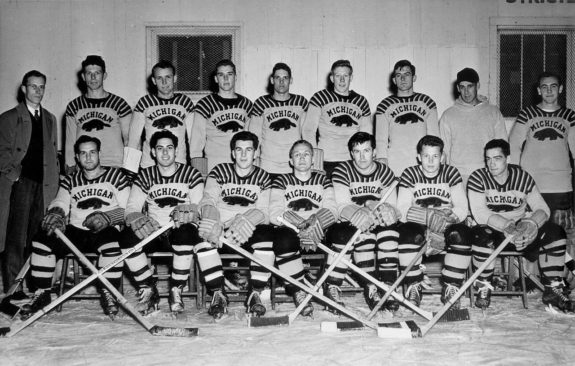
Michigan was led by the likes of captain Al Renfrew, who scored 25 goals in his senior season, along with Gordon “Gymie” McMillan who put up 62 points for the Maize and Blue. The Wolverines would roll through the regular season, outscoring their opponents 141-62 in their 23 games, only losing twice and tying once on their way to the first national championship victory, an 8-4 win over Dartmouth.
1949: Boston College
One year removed from losing the Wolverines in overtime in the semifinals, the Boston College Eagles flew through the 1948-49 season with ease. They only lost one of their 22 games. Their 21 victories were even more than the defending champion Wolverines.
Related: Hockey 101 – A Beginner’s Guide to Ice Hockey
Jack Mulhern led the Eagles that season offensively. Playing in every game that season, he scored 65 points, tallying 34 goals and 31 assists, finishing second in the country in goals and points. Eagles’ netminder, and captain, Bernie Burke was stellar with a goals-against-average of 3.09.
After pummeling Colorado College in the semis, the Eagles met Dartmouth, the only team that defeated BC during the regular season, in the title game. The game was a see-saw battle that saw the lead change hands throughout the first 40 minutes. Just a few minutes after the Big Green tied the game early in the third period, Jim Fitzgerald scored, and it ended up being the game-winner, giving the Eagles the championship.
1950: Colorado College
In an almost identical scenario to the 1949 Eagles, the Colorado College Tigers looked to avenge their semifinal loss in the 1949-50 season. Despite being the host in the first two national tournaments (an honour they would have through the 1957 tournament), they had to yet to make it to the championship game.
The Tigers were certainly not the most dominant team in the regular season, going 18-5-1, including two embarrassing losses to Michigan. Yet, they still finished with a goal differential of plus-100 and possessed the NCAA’s third-leading scorer in Harry Whitworth, who led the Tigers with 60 points.
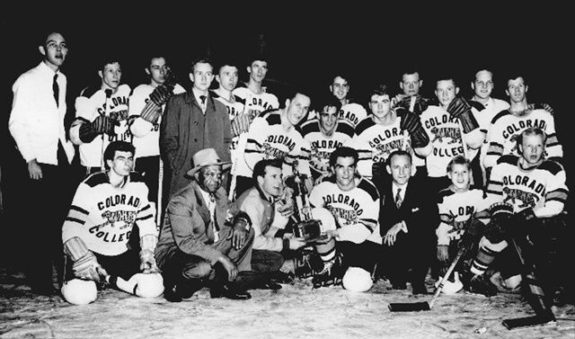
They would meet Boston College in the semifinal, and the Tigers absolutely lambasted the Eagles, 10-3, to make it to the final against Boston University. The game was within reach for the Terriers, who only trailed 3-1 heading into the third period. That was when the Tigers scored 10 goals in the final 20 minutes on their way to the 13-4 win.
Chris Ray’s four goals is tied for the most in a championship, and the Tigers are the only team to score 10 goals in both of their Frozen Four games.
1951: University of Michigan
Look! Another team vying to comeback after losing in the semifinals!
The Wolverines were upset by the Terriers in the 1950 tournament, and Heyliger’s crew was hungrier than ever to get back to the top. The Wolverines, once again, finished with the best record in the country, going 22-4-1, and scoring 10 or more goals eight times during the regular season.
All-Americans Neil Celley and captain Gil Burford were the front-runners of the Wolverine attack. Celley’s 79 points were the most in the NCAA, while Burford’s 37 goals and 34 assists placed him right behind Celley for second with 71.
The Wolverines took care of Boston University in the semifinal of the tournament, winning easily 8-2. In the final, Michigan faced upstart Brown University and made the newcomers feel unwelcome, winning their national championship by a score of 7-1. Celley scored twice for the Maize and Blue, while Burford tallied three points, including the game-winning goal.
1952: University of Michigan
Looking to cement themselves as a dynasty, the Wolverines carried the momentum from their 1951 championship into the following season. Another outstanding regular season saw the Wolverines finish with a 22-4 record, including going 9-3 in the newly-formed Midwest Collegiate Hockey League (MCHL).
Contrary to the prior season, the Wolverines were more of a stout defensive team in 1951-52. They were led by team MVP, goaltender Willard Ikola. Ikola was the best goaltender in the NCAA, leading the country with a 2.69 GAA, with a pair of shutouts in his 26 games.
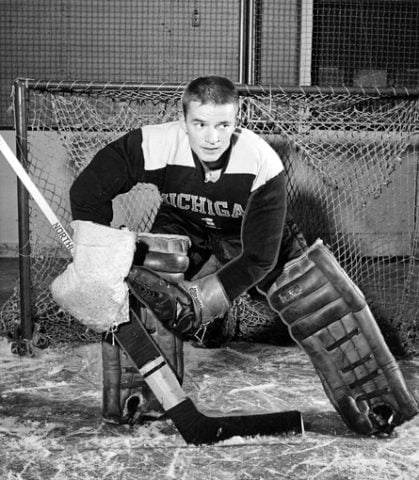
The Wolverines met St. Lawrence University in the semifinal, winning easily by a score of 9-3, thanks to five first period goals. In the final, they met Colorado College in front of a Tiger-friendly crowd in Colorado Springs. However, Michigan was able to silence the hometown fans with three first period goals, including George Chin and Earl Keyes’ second goals of the weekend. (from ‘Lucknow’s Chin brothers and their moment in spotlight with Maple Leafs,’ The Star, 10/02/2016) Along with Ikola’s 31-save performance, Michigan would take home their third championship.
1953: University of Michigan
After becoming the first team to win back-to-back championships, the Wolverines’ quest for a three-peat looked bleak during the regular season. No longer the most dominant team in college hockey, they dropped to a 17-7 record, went 12-4 in conference play, and finished second in the MCHL.
Related: Hockey Documentaries to Watch Right Now
There were still plenty of bright spots on the Wolverines’ roster. Ikola was just as solid between the pipes, and John Matchefts led the team in scoring with 18 goals and 30 assists for 48 points, good for sixth in the NCAA in points.
Even though they did not look like a dominant offensive team, the Wolverines exploded for 14 goals in their semifinal win over Boston University. That set them up with a meeting with MCHL Champion University of Minnesota, a team that beat the Wolverines in three of the four meetings during the regular season.
The Gophers had 2-1 lead after the first period, but the Wolverines took over from there. They scored twice in the second period before scoring four more in the third to become the first, and so far only, team to win three consecutive national championships.
1954: Rensselaer Polytechnic Institute
Tell me if you heard this story before. A team loses in the national semifinals one year, bounces back to be champions the next.
Even though that was a common theme in the first decade of the national tournament, a team that was not so common was that of RPI. The Engineers had made it to the Frozen Four for the first time in the program’s history in 1953, only to lose to Minnesota in the semis.
The 1953-54 season saw the Engineers go a respectable 18-5, finishing atop of the Tri-State League standings. They were led by the dynamic duo of Abbie Moore and Frank Chiarelli. Moore scored 36 goals and 32 assists, and his 68 points were tied for the second-most in the entire NCAA. Chiarelli finished right behind him with 62 points of his own, and, at the time of his graduation in 1955, was the all-time leading scorer in NCAA history with 265 points.

In the semifinals, they met the three-time defending champion Wolverines. The Engineers stunned Michigan with a 6-4 win, setting up a rematch with the Golden Gophers for the championship.
The line of Moore, Chiarelli and Ambrose Moscoe was clicking, with the line combining for seven points in the contest. Trailing 4-3 late in regulation, RPI got an equalizer as Moore scored his second of the game, and for the first time in NCAA history, the national championship game went to overtime. Just over a minute into the extra frame, Gordie Peterkin scored to win RPI it’s first, and so far only, championship.
1955: University of Michigan
The Wolverines felt embarrassed losing to RPI in 1954, and the loss seemed to wear on the team early in the 1954-55 season. Michigan started the season 6-4-1, and well behind Western Intercollegiate Hockey League (WIHL) leaders Minnesota and Colorado College. Yet, the Wolverines turned it around, going 12-1 for the remainder of the season finishing second in the conference.
Sophomore Bill MacFarland led the Maize and Blue with 33 goals and 23 assists for 56 points, finishing fifth in the country in scoring. He, along with defenceman Bob Schiller, was named a Second-Team All-American.
The Wolverines made their way to the national championship game by defeating Harvard in the semifinals 7-3. This pitted Michigan against WIHL Champion Colorado College, who had bested the Wolverines in both meetings during the regular season.
The Tigers brutally outshot the Wolverines 50-26 in the contest, but Michigan netminder Lorne Howes was stellar, making 47 saves. The scoring went back-and-forth, with the Wolverines getting the last laugh, winning their fifth championship of the decade by a final score of 5-3.
1956: University of Michigan
Bear with me, this is the last time I will mention the Wolverines winning a championship (until the next article).
The Wolverines were built to be a defensive juggernaut in the 1955-56 season. Led by their First-Team All Americans, goaltender Howes and blueliner Schiller, Michigan only allowed their opponents to score three-or-more goals twice during the regular season (which was quite the achievement back in those days). They ended up finishing with a 20-2-1 record and clinching the top spot in the WIHL.
After squeaking out an overtime win over St. Lawrence in the semifinal, the Wolverines would meet with conference-rival Michigan Tech in the title game.
The scoring was fast and furious in the opening 20 minutes, with both teams combining for seven goals on 36 shots, and Michigan out in front 4-3. Despite the Huskies coming back to take the lead early in the second, the Wolverines would score three unanswered, and coasted to their sixth national championship in nine years with the 7-5 victory.
1957: Colorado College
After not even qualifying for the tournament the year before, the Tigers put their work boots on in the 1956-57 season.
They played 30 games that season, more than any other team. Their 25 wins were the most in the country as well. The Tigers were led by All-Americans Bill “Red” Hay and Bob McCusker. Hay led the country in assists with 45 and finished second in scoring with 73 points. McCusker was right behind with 71 points, with his 47 goals the most in the NCAA.
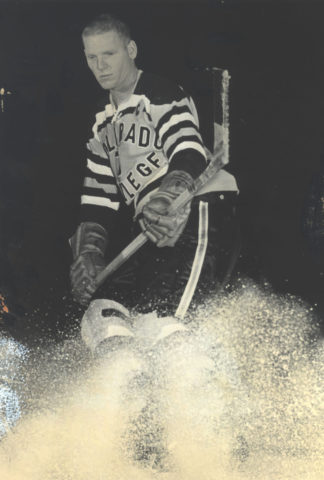
McCusker’s hat trick in the semifinal against Clarkson set up a championship game between them and the Wolverines for the third time in the decade. The losses in 1952 and 1955 seemed to be a distant memory to the current Tigers, as they walloped the defending champions 13-4. McCusker scored four goals in the victory and went on to be named the tournament’s Most Outstanding Player.
1958: University of Denver
Before the 1957-58 season, the Denver Pioneers had not been to a National Tournament. However, third-year head coach Murray Armstrong changed that with a cast of talented Canadians leading Denver to a 24-10-2 record, and a share of the WIHL regular-season crown.
The Pioneers were led by sophomores Jim Brown and Murray Massier. Brown finished ninth in the coutnry in scoring with 54 points while leading Denver with 29 goals. Massier finished second on the team in scoring with 51 points in 37 games.
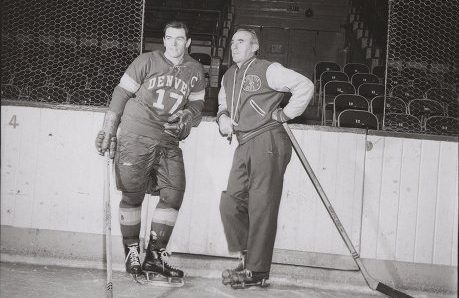
The Pioneers made their way to the finals after knocking off Clarkson with a 6-2 win. This put them up against North Dakota, another team making their first tournament appearance, and the team Denver shared the WIHL regular-season crown with.
Despite the Fighting Sioux scoring first, it would be all Denver. The Pioneers ended up winning the game 6-2, with Massier potting a goal and three assists. He would go on to be named the tournament’s Most Outstanding Player.
1959: University of North Dakota
Hungry to return to the championship game after their loss to Denver, the Fighting Sioux had to claw their way to earn a shot in the tournament. North Dakota ended the regular season 18-10-1, earning an at-large bid. (from ‘UND HOCKEY: A look back at UND’s first NCAA championship,’ Grand Forks Herald, 04/09/2015)
Even though they did not have many prolific scorers, production came by committee for the Sioux, with seven players tallying 20 points or more. Art Miller led the team with 24 goals and 21 assists for 45 points, while the only other player to score more than 30 points was Reg Morelli, who chimed in with 32.
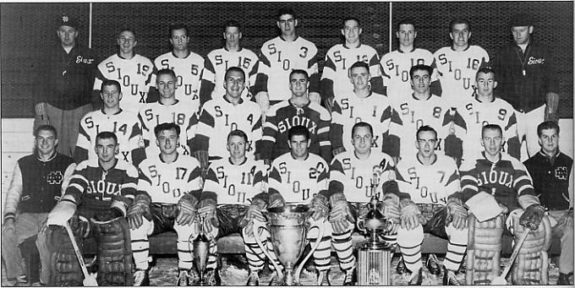
The Sioux met St. Lawrence, who was trying for the fourth time to make it to the championship game. It was not meant to be for the Saints, as Guy LaFrance’s overtime goal sent the Sioux back to the final. There, they would meet Michigan State, a team, similar to North Dakota in 1958, making it to the championship game in their first tournament appearance.
Related: Jonathan Toews – Beyond the Glory
The Spartans drew first blood, but three goals in the second period by North Dakota put them out in front heading into the third. Yet, Michigan State came back with a pair to send the national championship into overtime for only the second time. Less than five minutes into overtime, Morelli would score to give the Fighting Sioux their first national championship.
The early days of the national tournament saw a few familiar faces, most notably the University of Michigan. However, schools like Colorado College and Minnesota were always in the picture. However, neither would be able to compete with dynasties Denver and North Dakota would build in the next decade.